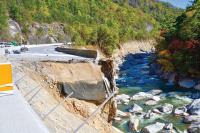This stretch of road deserves better care
To the Editor:
As a Macon County native who learned to drive in these mountains more than 40 years ago, I have driven in all kinds of weather, with and without four-wheel drive. That was not usually by choice, but because I was scheduled to be at work.
Living just off U.S. 64 between Highlands and Cashiers (less than a mile from the N.C. Department of Transportation maintenance shed), I now travel that stretch of road to town nearly every day — a route that takes me past Highlands-Cashiers Hospital.
On a recent morning, shortly before 9 a.m., I was on my way to work in Highlands. There was a very thin sheet of ice on the highway, which is always especially dangerous in the area between our house and the town limits. Although I was driving cautiously, and my Subaru has new tires and all-wheel drive, I slid several times between our house and Highlands-Cashiers Hospital. I finally came to a stop in a long line of traffic, which not only blocked the road into town but more importantly blocked the only entrance to the hospital. Clearly, N.C. Department of Transportation crews had made no attempt to chat the road.
Eventually, a DOT truck arrived, and the line of traffic proceeded slowly towards town. By then, I was late for work and I suspect others were as well. However, this letter is not about getting to work on time, but about saving lives. Because it provides the only access to the hospital, this part of U.S. 64 is a critical stretch of road. Unfortunately, this was not an isolated incident. Similar situations occurred numerous times last winter despite a promise by DOT to county commissioners to give this stretch of road priority during bad weather.
On a recent Wednesday morning on my way to work, I turned onto Highway 64 towards Highlands. As soon as I got onto the highway, a vehicle coming towards me flashed its headlights. I slowed down, rounded the curve, and saw a vehicle flipped on its side. The driver had apparently hit a patch of ice. A fire truck and ambulance were at the scene. Once again, DOT failed to address the dangerous road conditions.
What will it take before our DOT realizes that this particular stretch of road is usually icy, even when other areas are not? What will it take before they realize that most of us who travel that road are on our way to work early in the morning? What will it take before they realize that, if traffic is blocking the entrance to Highlands-Cashiers Hospital, essential personnel and emergency vehicles cannot get through?
What will it take—a life-threatening emergency or a fatal accident on the highway? I hope not.
Mary Ann Sloan
Highlands





